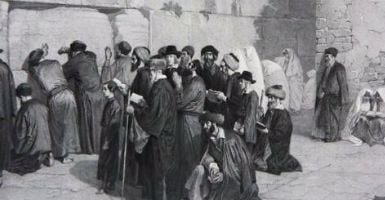Over the past several weeks[1], we have discussed the question of physician credibility in areas of Halacha. We reviewed several Sugyos and Rishonim that give rise to varying approaches, ranging from ascribing absolute Ne’emanus to physicians, treating their conclusions with caution and involving a Rav to give his perspective, or, in some cases, not granting them any Ne’emanus at all.
We also explained that even those who do not grant Ne’emanus to physicians in some circumstances do concede that a physician’s opinion is relied upon to determine whether a sick person can fast on Yom Kippur, as stated explicitly in Shulchan Aruch. This is because it is a matter of Pikuach Nefesh. Since even a Safek Pikuach Nefesh overrides all of the Mitzvos, we must take a physician’s warning into account, for even if we don’t rely entirely upon his opinion, we certainly give it enough weight to raise a Safek.
This essay will examine various fascinating comments of the Chasam Sofer on this topic:
In one Teshuva (Y.D. 175), the Chasam Sofer was asked about a woman who experienced post-coital bleeding on three occasions. The Sho’el related that a non-Jewish physician had assured him that he was able to cure her; the Sho’el wondered whether the physician had any Ne’emanus.
However, at the end of the Sha’ala, the Sho’el seems to say that he had been mistaken as to facts of the case. The physician had not claimed he could cure the women but that the bleeding was not from the uterus; it was from the vagina, which would not render her a Nida. The question was, did he have any Ne’emanus to make this claim?
The Chasam Sofer begins by elaborating on the Halacha of a woman who experiences post-coital bleeding, which is not relevant to this essay. Then he begins discussing the Ne’emanus of physicians. After citing a Machlokes Rishonim on the topic (see our previous essays), he quotes several Poskim who hold that physicians are only believed to raise a Safek, as explained above. Therefore, their words are only given credence in matters of Pikuach Nefesh. In other matters, they do not have Ne’emanus, or at least, we must confirm whether they are correct.[2]
The Chasam Sofer makes the following comment about this approach:
Logically, we should follow these Gaonim [who argue] that we do not believe physicians when we can clarify [the matter]. Nevertheless, it seems to me that this does not provide a clear enough explanation for us to resolve the question of the aforementioned Rosh; for the wording of the Gemara does not imply as such.
The Chasam Sofer is referring to the Gemara in Nida (22b) quoted in the first essay of this series:
R’ Elazar bar R’ Tzadok said: My father raised two incidents from Tivin to the Sages in Yavneh [for discussion]. [The first was] an incident involving a woman who would [repeatedly] discharge objects similar to red shells, and they came and asked my father [whether this rendered her impure]. My father asked the Sages, and the Sages asked physicians [what the shells were]. The physicians replied: This woman has a wound in her uterus from which she discharges these shells [they are scabs of the wound and not congealed blood[3]]. She should cast them into water [to determine what they are]. If they dissolve [it is blood and] she is impure.
We then cited the following question of the Rosh to the Rashba (Shu”t 2:18):
My teacher should also enlighten me by explaining the Gemara in Perek haMapeles (Nida 22b)… It is difficult to me. Since the blood came from a wound, why was she impure? Surely, it is stated in Perek Kol haYad (ibid. 16) that if a woman discharges blood from a wound, even if it is during the days that she regularly menstruates, she is pure… We see that even if blood comes from the Mekor (the cervix), she is pure since it came from a wound.
In other words, the Rosh could not understand the purpose of placing the discharge in water to determine whether it was blood. Since the doctors asserted that the woman had a wound, and blood from a wound (“Dam Maka”) does not render a woman a Nida even if it comes from the Mekor, what would be gained by conducting the test? Even if it was determined to be blood, the woman should not be considered a Nida!
Unfortunately, we have no record of the Rashba’s response to this question nor to any other comments on this matter by the Rosh. We cited several approaches to answering the Rosh’s question in the aforementioned essay. The Chasam Sofer asserts that although some suggest that there is a distinction between cases where it is possible to verify the physician’s claim and cases where it is not, this is not the implication of the Gemara. He therefore establishes an important concept:
I have already explained in another Teshuva that the words of physicians are only conjecture, as stated by the Me’il Tzedaka, as they themselves concede that their wisdom is only theoretical, therefore they are [only] believed in a general sense, not about the specific [case].
I mean to say that they are believed to say, “Scientifically, the kidneys can produce a trace of blood”, but they are not believed about this specific [case to say] that the kidneys in this body have a trace [of blood]. For perhaps their minds are misleading them, causing them to pronounce a false diagnosis with regard to this body.
With regard to the woman who discharged shell-like or hair-like objects. If we would only place them in lukewarm water and see that they do not dissolve, we would nevertheless not consider a new possibility that she has a scab. Rather, we would attribute [the discharges] to dried blood. And if the physicians had said, “This body has a scab”, we would not believe them about this particular body. However, the Chachamim did at least believe them that there is a biological possibility that a woman can have a scab from which she may discharge hair-like or shell-like objects. Chaza”l then checked [the discharges] and they did not dissolve, from which they proved that this woman had a scab, given that the physicians had attested that this phenomenon exists in the world. This appears to be the correct approach to answering the question of the Rosh.
In other words, the Chasam Sofer distinguishes between two different assertions of a physician:
- Providing General Medical Information: If a physician informs us of any medical information, such as the existence of a certain illness with certain symptoms, with no connection to a specific patient, he is believed entirely.
- Diagnosis: If he wants to apply his knowledge to diagnose a specific patient, he does not necessarily have Ne’emanus. The reason for this is that physicians concede that most of their expertise is based on theoretical knowledge; their diagnoses are purely based on an estimation. Therefore, we do not believe them without checking their conclusions for ourselves.
The Chasam Sofer elaborates further but the basic concept is stated above. Can his comments be used to explain the Gemara in Nida? According to his approach we must say that the Chachamim only believed the physicians with regard to their medical information, but not to establish a diagnosis. In fact, this sits well with the Chachamim’s approach of placing the discharges into water to see if they would dissolve. Since they could not believe the physicians that the woman actually had a scab (they could only trust them that a scab can be the cause of these types of discharges), they needed to check the matter for themselves.
HaGaon Rav Asher Weiss Shlit”a discusses whether the Chasam Sofer’s approach fits with several Sugyos in Shas:
Killing a Treifa
A person who murders a Treifa (a person who cannot live for an extended period due to a medical condition or injury) is exempt. How do we know if a person is a Treifa? The Rambam explains (Hilchos Rotze’ach 2:8):
Every person is assumed to be healthy, and one who murders him is executed unless it is determined conclusively that he is a Treifa. Physicians must say that his [underlying] wound [or illness] cannot be healed and [would have] cause[d] him to die if something else did not kill him.
Ostensibly, this protocol appears to ascribe Ne’emanus to physicians’ diagnosis of a specific person, and not just provide general medical information, unlike the assertion of the Chasam Sofer.
However, Rav Asher argued that this can be resolved in one of two ways: First, the Rambam may refer to a case when the existence of a medical condition has already been corroborated by witnesses. The physicians are only asked whether this condition usually prevents a person from living for an extended period. Second, we explained above that everyone concedes that in cases of Pikuach Nefesh physicians are believed to raise a Safek. In this case, the murderer’s life is on the line – if we believe the physicians’ diagnosis of the Treifa, he will not be executed. Therefore, the Chasam Sofer would agree that we ascribe Ne’emanus to them, even though they are offering a specific diagnosis.
Perhaps we may propose a third answer:
The Chasam Sofer states explicitly that the reason physicians’ diagnoses have no Ne’emanus is because they are purely based on estimation (“Omed haDa’as”). It is very likely that the diagnosis of a Treifa, referred to by the Rambam, related to an external wound rather than an internal illness (e.g., cancer). If so, even the Chasam Sofer would agree that the physicians’ diagnosis can be accepted since it is based on examining an external, visible wound (about which they can directly apply their medical knowledge), and not just “Omed haDa’as”. Moreover, if we are discussing a visible wound, we are able to examine it for ourselves, as was the case in the Gemara in Nida.
A Get on Condition
If a person gives his wife a Get “on condition that I die from this illness”, and he subsequently dies, we must determine whether he did indeed die from that illness (Gitin 72b). This surely implies that a physician (or coroner) is believed to give a specific assessment (as he must conclusively determine how this man died), and not just provide medical information.
The three approaches we offered to resolve the previous question do not help in this case:
- There is nobody else who is aware of the dead man’s condition apart from the physician. Therefore, we must be relying upon him to offer a specific diagnosis.
- In this case it is not sufficient merely to raise a Safek as it is not a matter of Pikuach Nefesh. On the contrary, we are relying on the physician’s diagnosis as a matter of certainty and treating her as a divorcee and not as a widow.[4]
- There is no reason to believe that we are only discussing an external wound.
Therefore, it seems that this Sugya contradicts the Chasam Sofer. We must point out that the Chasam Sofer’s contention appears to be only relevant to his era during which the diagnostic tools were extremely limited, thus physicians relied heavily – and nearly exclusively – upon “Omed haDa’as”. As we noted, even the Chasam Sofer likely agrees that a diagnosis of an external wound is believed, as the physician simply identifies the wound as one that he has studied and is familiar with. The same should apply to the diagnoses offered today, which are based on advanced tools and imaging.
For example, while the diagnosis of the physicians in the case of the Gemara in Nida was clearly based on Omed haDa’as, today a woman with unusual discharges would be evaluated for signs of an infection and undergo direct examination and diagnostic imaging. Based on the results, physicians would likely be able to offer an unequivocal diagnosis. This would be granted Ne’emanus even according to the Chasam Sofer.
Obviously, there are cases in which the diagnosis is unclear or not yet confirmed and Omed haDa’as is still necessary, but modern diagnostic ability is vastly superior to the era of the Chasam Sofer [and his Psak would not necessarily apply today.]
[1] See Acharei Mos and Kedoshim 5782
[2] [Editor’s note: i.e., we cannot accept their opinion(s) blindly and must independently verify their claim(s)]
[3] Rashi ad. loc., s.v. Klipos
[4] [Editor’s note: This would have practical ramifications if the husband did not have children and she therefore would require Chalitza in order to marry, or if she wished to marry a Kohen who is prohibited from marrying a divorcee but permitted to marry a widow.]














